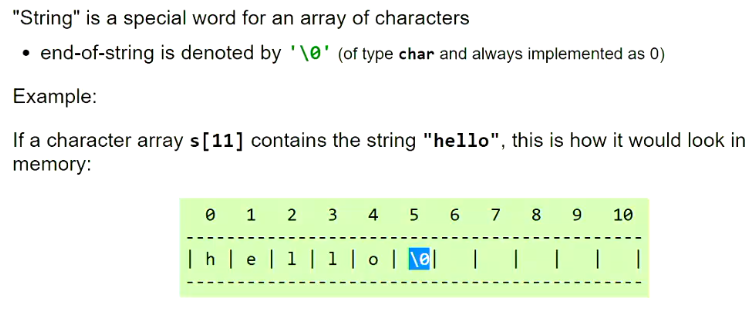lecture 9.18
1. a && b: a and b; a || b: a or b
2. printf格式
%d 十进制
%f 小数点位置固定的数 (%m.nf, 字段长度为m位,空格补位,小数点后n位)
%c character
%s string
\n new line
\" quotation mark
3. while与do while的区别是后者至少进行一次
4. putchar(c)的作用是向终端输出一个字符,当c为被单引号引出的字符时输出该字符(可以为转义字符如\n),当c为介于0-127之间的十进制整型数时,输出该数字在ASCII码中对应的字符
5. functions form
return-type function-name(parameters) {
declarations
statements
return ...;
}
if return-type is void then the function does not return a value
if parameters is void then the function has no arguments
parameter中的赋值会被计算,如f=3*3, f=9会被传递
6. the return statement can also be used to terminate a function of return-type void
return;
7. double很像float,但是精度更高小数点后所允许的位数更多
8. array is similar with list in python, which is a collection of same-type variables, for an array of size N, valid subscripts are 0...N-1
9. #define放在开始,便于理解且便于修改,在assignment中不可以直接使用没有定义过的数
10. C代码格式参照 https://wiki.cse.unsw.edu.au/info/CoreCourses/StyleGuide
11. strings (functions不知道array的大小,所以对array的结尾进行标记)

12. string是特殊形式的array,下面两者都可以,但是第二个可读性更高
char s[6] ={ 'h', 'e', 'l', 'l', 'o', '\0' };
char t[6] = "hello";
13. input用scanf(format-string, expr1...), 不想input string时,用atoi(string), which convert string into integer
需要先#include <stdlib.h>
14. typedef的作用是给type取一个新名字
15. structures可以是一个不同types结合起来的结果,复杂data时很有用,如:
typedef struct {
int day;
int month;
int year;
} DateT;
小的structure可以包含在一个更大的structure里面
声明变量以分配内存如 DateT christmas;
christmas.day = 25;
christmas.month = 12;
christmas.year = 2019;
16. stack is first in last out, 不同于array你不能根据它的顺序将里面的元素提取出来,只能按照先进后出的原则来取,在递归中就用到了stack
与queue不同
17. 自己的herder file要用#include "Stack.h"格式



